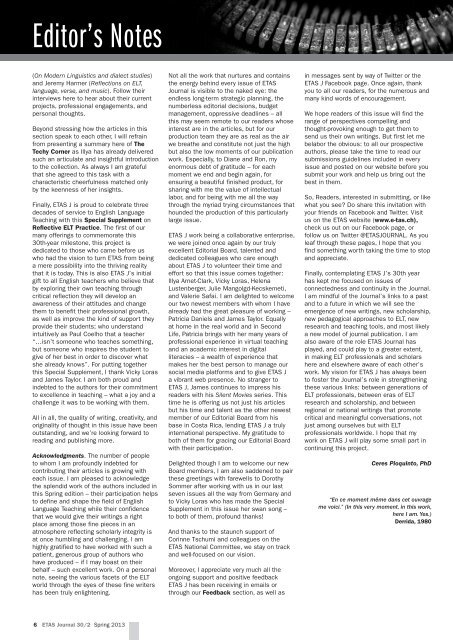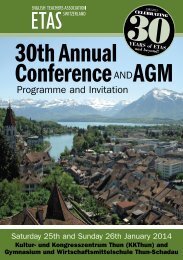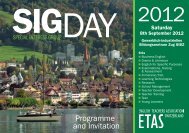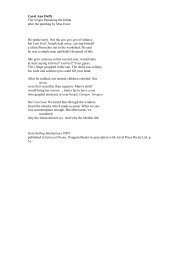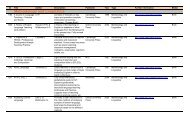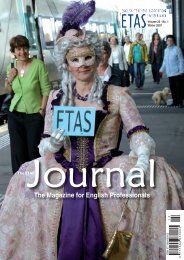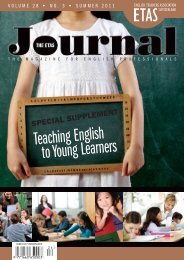Spring Journal 2013 - English Teachers Association of Switzerland
Spring Journal 2013 - English Teachers Association of Switzerland
Spring Journal 2013 - English Teachers Association of Switzerland
You also want an ePaper? Increase the reach of your titles
YUMPU automatically turns print PDFs into web optimized ePapers that Google loves.
Editor’s Notes(On Modern Linguistics and dialect studies)and Jeremy Harmer (Reflections on ELT,language, verse, and music). Follow theirinterviews here to hear about their currentprojects, pr<strong>of</strong>essional engagements, andpersonal thoughts.Beyond stressing how the articles in thissection speak to each other, I will refrainfrom presenting a summary here <strong>of</strong> TheTechy Corner as Illya has already deliveredsuch an articulate and insightful introductionto the collection. As always I am gratefulthat she agreed to this task with acharacteristic cheerfulness matched onlyby the keenness <strong>of</strong> her insights.Finally, ETAS J is proud to celebrate threedecades <strong>of</strong> service to <strong>English</strong> LanguageTeaching with this Special Supplement onReflective ELT Practice. The first <strong>of</strong> ourmany <strong>of</strong>ferings to commemorate this30th-year milestone, this project isdedicated to those who came before uswho had the vision to turn ETAS from beinga mere possibility into the thriving realitythat it is today. This is also ETAS J’s initialgift to all <strong>English</strong> teachers who believe thatby exploring their own teaching throughcritical reflection they will develop anawareness <strong>of</strong> their attitudes and changethem to benefit their pr<strong>of</strong>essional growth,as well as improve the kind <strong>of</strong> support theyprovide their students; who understandintuitively as Paul Coelho that a teacher“…isn’t someone who teaches something,but someone who inspires the student togive <strong>of</strong> her best in order to discover whatshe already knows”. For putting togetherthis Special Supplement, I thank Vicky Lorasand James Taylor. I am both proud andindebted to the authors for their commitmentto excellence in teaching – what a joy and achallenge it was to be working with them.All in all, the quality <strong>of</strong> writing, creativity, andoriginality <strong>of</strong> thought in this issue have beenoutstanding, and we’re looking forward toreading and publishing more.Acknowledgments. The number <strong>of</strong> peopleto whom I am pr<strong>of</strong>oundly indebted forcontributing their articles is growing witheach issue. I am pleased to acknowledgethe splendid work <strong>of</strong> the authors included inthis <strong>Spring</strong> edition – their participation helpsto define and shape the field <strong>of</strong> <strong>English</strong>Language Teaching while their confidencethat we would give their writings a rightplace among those fine pieces in anatmosphere reflecting scholarly integrity isat once humbling and challenging. I amhighly gratified to have worked with such apatient, generous group <strong>of</strong> authors whohave produced – if I may boast on theirbehalf – such excellent work. On a personalnote, seeing the various facets <strong>of</strong> the ELTworld through the eyes <strong>of</strong> these fine writershas been truly enlightening.Not all the work that nurtures and containsthe energy behind every issue <strong>of</strong> ETAS<strong>Journal</strong> is visible to the naked eye: theendless long-term strategic planning, thenumberless editorial decisions, budgetmanagement, oppressive deadlines – allthis may seem remote to our readers whoseinterest are in the articles, but for ourproduction team they are as real as the airwe breathe and constitute not just the highbut also the low moments <strong>of</strong> our publicationwork. Especially, to Diane and Ron, myenormous debt <strong>of</strong> gratitude – for eachmoment we end and begin again, forensuring a beautiful finished product, forsharing with me the value <strong>of</strong> intellectuallabor, and for being with me all the waythrough the myriad trying circumstances thathounded the production <strong>of</strong> this particularlylarge issue.ETAS J work being a collaborative enterprise,we were joined once again by our trulyexcellent Editorial Board, talented anddedicated colleagues who care enoughabout ETAS J to volunteer their time andeffort so that this issue comes together:Illya Arnet-Clark, Vicky Loras, HelenaLustenberger, Julie Mangolgd-Kecskemeti,and Valerie Safai. I am delighted to welcomeour two newest members with whom I havealready had the great pleasure <strong>of</strong> working –Patricia Daniels and James Taylor. Equallyat home in the real world and in SecondLife, Patricia brings with her many years <strong>of</strong>pr<strong>of</strong>essional experience in virtual teachingand an academic interest in digitalliteracies – a wealth <strong>of</strong> experience thatmakes her the best person to manage oursocial media platforms and to give ETAS Ja vibrant web presence. No stranger toETAS J, James continues to impress hisreaders with his Silent Movies series. Thistime he is <strong>of</strong>fering us not just his articlesbut his time and talent as the other newestmember <strong>of</strong> our Editorial Board from hisbase in Costa Rica, lending ETAS J a trulyinternational perspective. My gratitude toboth <strong>of</strong> them for gracing our Editorial Boardwith their participation.Delighted though I am to welcome our newBoard members, I am also saddened to pairthese greetings with farewells to DorothySommer after working with us in our lastseven issues all the way from Germany andto Vicky Loras who has made the SpecialSupplement in this issue her swan song –to both <strong>of</strong> them, pr<strong>of</strong>ound thanks!And thanks to the staunch support <strong>of</strong>Corinne Tschumi and colleagues on theETAS National Committee, we stay on trackand well-focused on our vision.Moreover, I appreciate very much all theongoing support and positive feedbackETAS J has been receiving in emails orthrough our Feedback section, as well asin messages sent by way <strong>of</strong> Twitter or theETAS J Facebook page. Once again, thankyou to all our readers, for the numerous andmany kind words <strong>of</strong> encouragement.We hope readers <strong>of</strong> this issue will find therange <strong>of</strong> perspectives compelling andthought-provoking enough to get them tosend us their own writings. But first let mebelabor the obvious: to all our prospectiveauthors, please take the time to read oursubmissions guidelines included in everyissue and posted on our website before yousubmit your work and help us bring out thebest in them.So, Readers, interested in submitting, or likewhat you see? Do share this invitation withyour friends on Facebook and Twitter. Visitus on the ETAS website (www.e-tas.ch),check us out on our Facebook page, orfollow us on Twitter @ETASJOURNAL. As youleaf through these pages, I hope that youfind something worth taking the time to stopand appreciate.Finally, contemplating ETAS J’s 30th yearhas kept me focused on issues <strong>of</strong>connectedness and continuity in the <strong>Journal</strong>.I am mindful <strong>of</strong> the <strong>Journal</strong>’s links to a pastand to a future in which we will see theemergence <strong>of</strong> new writings, new scholarship,new pedagogical approaches to ELT, newresearch and teaching tools, and most likelya new model <strong>of</strong> journal publication. I amalso aware <strong>of</strong> the role ETAS <strong>Journal</strong> hasplayed, and could play to a greater extent,in making ELT pr<strong>of</strong>essionals and scholarshere and elsewhere aware <strong>of</strong> each other’swork. My vision for ETAS J has always beento foster the <strong>Journal</strong>’s role in strengtheningthese various links: between generations <strong>of</strong>ELT pr<strong>of</strong>essionals, between eras <strong>of</strong> ELTresearch and scholarship, and betweenregional or national writings that promotecritical and meaningful conversations, notjust among ourselves but with ELTpr<strong>of</strong>essionals worldwide. I hope that mywork on ETAS J will play some small part incontinuing this project.Ceres Pioquinto, PhD“En ce moment même dans cet ouvrageme voici.” (In this very moment, in this work,here I am. Yes.)Derrida, 19806 ETAS <strong>Journal</strong> 30/2 <strong>Spring</strong> <strong>2013</strong>


